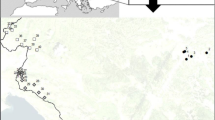Abstract
We investigated the genetic population structure of two rare myrmecophilous lycaenid butterflies, Maculinea nausithous and M. teleius, which often live sympatrically and have similar biology. In Europe, both species occur in highly fragmented populations and are vulnerable to local extinction. The proportion of variable allozyme loci, average heterozygosity and genetic differentiation among populations was higher in M. nausithous than in sympatrically living M. teleius populations. We hypothesise that the differences in heterozygosity are mainly due to the known higher efficiency of typical host ant nests in rearing M. nausithous pupae compared to M. teleius pupae. This implies a larger probability of larval survival in M. nausithous, which buffers populations against environmental and demographic stochasticity. In contrast, the lower carrying capacity of ant nests in rearing M. teleius pupae requires higher nest-densities and makes M. teleius populations more prone to losing genetic variation through drift if this condition is not fulfilled. The single investigated Russian population of M. teleius showed much higher levels of heterozygosity than any of the Polish populations, suggesting a more viable and still intact metapopulation structure.
Similar content being viewed by others
References
Buszko J (1997) Atlas Rozmieszczenia Motyli Dziennych w Polsce. Turpress, Torun
Costa JT, McDonald JH and Pierce NE (1996) The effect of ant association on the population genetics of the Australian butterfly Jalmenus evagoras (Lepidoptera, Lycaenidae). Biological Journal of the Linnean Society 58: 287–306
Elmes GW, Thomas JA, Wardlaw JC, Hochberg ME, Clarke RT and Simcox DJ (1998) The ecology of Myrmica ants in relation to the conservation of Maculinea butterflies. Journal of Insect Conservation 2: 67–78
Elfferich NW (1998) New facts on the life history of the dusky large blue Maculinea nausithous (Lepidoptera, Lycaenidae) obtained by breeding with Myrmica ants in plaster nests. Deinsea 4: 97–102
Fiedler K (1990) New information on the biology of Maculinea nausithous and M. teleius. Nota Lepidoptera 12: 246–256
Figurny E (1996) Parasitism of Maculinea teleius and M. nausithous in Myrmica scabrinodis and M. rubra colonies. International Maculinea Workshop, Wageningen, The Netherlands
Figurny E and Woyciechowski M (1998) Flowerhead selection for oviposition by females of the sympatric butterfly species Maculinea teleius and M. nausithous (Lepidoptera, Lycaenidae). Entomologie Generalis 23(3): 215–222
Gadeberg RME and Boomsma JJ (1997) Genetic population structure of the large blue butterfly Maculinea alcon in Denmark. Journal of Insect Conservation 1: 99–111
Gilpin M (1991) The genetic effective size of a metapopulation. Biological Journal of the Linnean Society 42: 165–175
Goudet J (1995) F-stat version 1.2, A computer program to calculate F-statistics. Journal of Heredity 86: 485–486
Hanski I and Gilpin M (1991) Metapopulation dynamics, brief history and conceptual domain. Biological Journal of the Linnean Society 42: 3–16
Hanski I and Thomas CD (1994) Metapopulation dynamics and conservation, a spatially explicit model applied to butterflies. Biological Conservation 68: 167–180
Harrison S (1991) Local extinction in ametapopulation context: an empirical evaluation. Biological Journal of the Linnean Society 42: 73–88
Hochberg ME, Clarke RT, Elmes GW and Thomas JA (1994) Population dynamic consequences of direct and indirect interactions involving a large blue butterfly and its plant and red ant hosts. Journal of Animal Ecology 63: 375–391
Johannesen J, Veith M and Seitz A (1996) Population genetic structure of the butterfly Melitea didyma (Nymphalidae) along a northern distribution range border. Molecular Ecology 5: 259–267
McCauley DE (1991) Genetic consequences of local population extinction and recolonization. Trends in Ecology and Evolution 6: 5–8
Nei M (1972) Genetic distance between populations. American Naturalist 106: 283–292
Pimm SL, Jones HL and Diamond J (1988) On the risk of extinction. American Naturalist 132: 757–785
Raymonnd M and Rousset F (1995) Genepop (version. 1.2). A population genetic software for exact tests and ecumenicism. Journal of Heredity 86: 248–249
Rice WR (1989) Analysing tables of statistical tests. Evolution 43: 223–225
Richardson BJ, Baverstock PR and Adams M (1986) Allozyme Electrophoresis–A Handbook for Animal Systematics and Population studies. Academic Press, San Diego, California
Saccheri I, KuussaariM, Kankare M, Vikman P, Fortelius W and Hanski I (1998) Inbreeding and extinction in a butterfly metapopulation. Nature 392: 491–494
Sokal RR and Rohlf FJ (1995) Biometry. 3rd ed. WH Freeman and Company, New York
Thomas JA (1984) The behaviour and habitat requirements of Maculinea nausithous (the dusky large blue butterfly) and M. teleius (the scarce large blue) in France. Biological Conservation 28: 325–347
Thomas JA and Wardlaw JC (1992) The capacity of a Myrmica ant nest to support a predacious species of Maculinea butterfly. Oecologia 91: 101–109
Thomas JA, Elmes GW, Wardlaw JC and Woyciechowski M (1989) Host specificity among Maculinea butterflies in Myrmica ant nests. Oecologia 79: 452–457
Thomas JA, Clarke RT, Elmes GW and Hochberg ME (1998) Population dynamics in the genus Maculinea (Lepidoptera, Lycaenidae). In: Dempster JP and Mc Lean IF (eds) Insect Populations in Theory and Practice. Symposia of the Royal Entomological Society 19, pp 261–290. Chapman & Hall, London
Wade MJ and McCauley DE (1988) Extinction and recolonization, their effects on the genetic differentiation of local populations. Evolution 42: 995–1005
Weir BS and Cockerham CC (1984) Estimating F-statistics for the analysis of population structure. Evolution 38: 1358–1370
Wells SM, Pyle RM and Collins NM (1983) The IUCN Red Data Book, Invertebrates. IUCN, Gland, Switzerland
Wright S (1943) Isolation by distance. Genetics 28: 114–138
Wynhoff I (1998a) The recent distribution of the European Maculinea species. Journal of Insect Conservation 2: 15–27
Wynhoff I (1998b) Lessons from reintroduction of Maculinea teleius and M. nausithous in the Netherlands. Journal of Insect Conservation 2: 47–57
Wynhoff I and Van der Made JG (1995) Reintroduction of Maculinea teleius and M. nausithous in the Netherlands in 1990. Proceedings of Experimental and Applied Entomology 6: 79–80
Author information
Authors and Affiliations
Rights and permissions
About this article
Cite this article
Figurny-Puchalska, E., Gadeberg, R.M. & Boomsma, J.J. Comparison of genetic population structure of the large blue butterflies Maculinea nausithous and M. teleius. Biodiversity and Conservation 9, 419–432 (2000). https://doi.org/10.1023/A:1008970232079
Issue Date:
DOI: https://doi.org/10.1023/A:1008970232079




